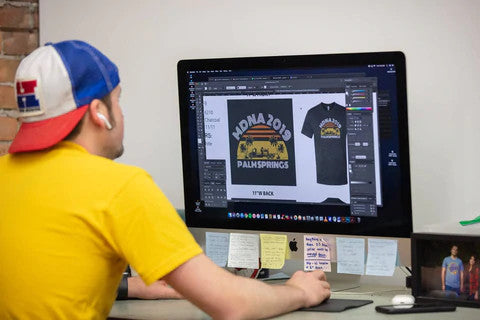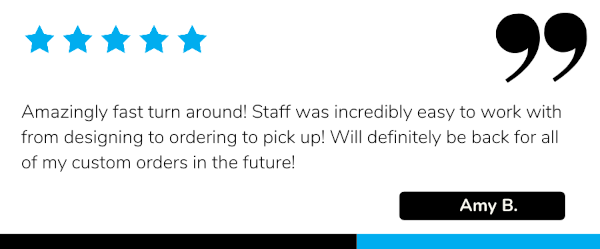Your company uniform is more than just a garment. It can impact your brand at the customer, business, and employee level.
At the customer level, company apparel can act as a sign of trustworthiness. It showcases your employees as professionals, which will improve customer perceptions. Even better, it becomes easier for customers to identify your employees.
At the employee level, company uniforms can be great for inspiring team spirit. It also increases employee morale—people are more likely to perform well when they look and feel good.
"The pride we take in our appearance should make us feel good when we help customers. It's a reminder that each one of us is part of something big..."
- Barbara Simone, a Walmart human resources executive.
Most importantly, custom uniforms can act as safety apparel, helping to keep your employees out of harm’s way.
At the business level, corporate apparel can help solidify your brand identity. Uniforms can be used to showcase brand colors, logos, and overall values.
To enjoy the perks that custom company uniforms provide, you need to create a strong corporate apparel program. You’ll need to ensure that every part of the process is catered to, from uniform design to stock management.
Here’s a simple guide to help you create a comprehensive corporate apparel program:
Create the Ideal Apparel Design
At the bare minimum, the apparel design you choose needs to be practical, comfortable, and safe for employees to use. You must always consider the circumstances in which your staff members will be using the uniforms you design.
Most importantly, your employees should be happy with the final design choice. Be sure to consult employees on their ideal dress code.

Here are four considerations for designing your corporate apparel:
Pick Practical Clothes
The ideal apparel for your workforce should allow your employees to execute their duties without constraint. Consider the environment in which your employees spend their time.
There could be safety and health codes that your workforce needs to comply with. For instance, if you’re in the construction industry, you’ll need to invest in safety equipment like helmets, gloves, and hi-vis clothing.
An employee in the hospitality industry moves around often, sweats, and encounters spills during a typical workday. The ideal workwear for them is a professional-looking apron that will protect their clothes from spills. Consider investing in clothes that are easy to move around in throughout the day as well.
As for employees who work in an office environment, a suit, t-shirt, or dress pants will suffice. The apparel should represent your brand colors and values while making your employees look professional and approachable.
Choose Suitable Uniform Colors
A rule of thumb for most businesses is to use a brand color as the base color for their uniforms. This strategy ensures consistent branding across the various sectors of your business.
However, colors should also factor in where employees will use the uniform. For instance, construction workers need to wear bright-colored uniforms when they’re at work for safety reasons.
When deciding on colors, inject some color psychology into your choices. How do you want people to perceive your workforce? While yellow will portray your team as enthusiastic, black will make them look more professional.
Expert tip: Pick a color that contrasts with your base color to make the design easily visible. For instance, a red logo printed on a white t-shirt.
Be Intentional With the Fabric Choice
Low-quality fabrics might be cheap at first glance, but they’ll be expensive in the long run since they’ll have to be replaced often. Instead, choose fabrics that are durable in nature.
Cotton, polyester, and rayon are great fabrics for employees who move around a lot, like restaurant staff. These fabrics don’t restrict movement.
If your employees spend the bulk of their day outdoors, consider uniforms that will keep them warm on cold days. Wool and blended wool will be ideal for this situation.
Most importantly, consider what it will take to maintain the fabric you choose. Fabrics that require frequent dry cleaning, like suede and denim, might not be practical for your employees. Instead, choose easy-wash fabrics like cotton and jersey.
Ideal Logo Placement
If your staff will be working far away from customers, consider printing a large onto your company apparel for easy identification. Smaller logos will be ideal for employees who work face-to-face with customers.
Place your logos on the chest, back, or sleeve of a garment. You want the logo to be placed where it can easily be seen.
The method you use to print your logo onto apparel will also impact the overall look of your company apparel. The table below describes a few different ways to add a logo to your apparel.
| Method | Description | Benefit |
| Screen printing | Involves using a meshed screen to transfer a pre-designed image onto a piece of cloth |
|
| Digital printing | Involves printing designs derived from a computer-generated image onto apparel |
|
| Embroidery | Involves stitching your logo directly onto your corporate apparel |
|
Corporate Apparel Inventory Management
Inventory management can be easy to ignore in a corporate apparel program. However, ignoring it could lead to inconveniences to your employees, or even the failure of your apparel program.
A great inventory management program allows your business to control how you:
- List uniform inventory
- Purchase and replace uniforms
- Offer new recruits corporate apparel
- Manage workwear budgets
The need for proper inventory management increases the more a business grows. To run a successful inventory management program, you’ll need to:
Note Your Basic Corporate Apparel Needs
Having an understanding of your basic uniform requirements will help with the entire planning process. You’ll know when, how, and where to replace your corporate apparel when the need arises.
At the bare minimum, you should determine the following:
- Your current staff numbers
- The rate of staff churn and recruitment
- The frequency of uniform replacement
- The complexity of every uniform
- The budget needed to run your uniform program
Use the information above to set up a successful inventory management process for your corporate apparel.
Track Your Uniform Program
Once you have a firm understanding of your basic uniform program, you can start building a structure for tracking the uniforms you have in circulation. You’ll need to identify who has what type of uniform, whether the uniform is due for replacement, and how soon you can replace existing uniforms.
You don’t have to rely on Excel to track your corporate apparel program. There are multiple management systems that can help you keep everything in check. Additionally, when we run inventory programs for our customers, we provide monthly sales reports to help track inventory.
Pro Tip: It's always a best practice to keep things simple to start and grow from there.
Plan For Uniform Replacement and Maintenance
Several factors will determine the frequency of an employee’s uniform replacement. For instance, the fabric, the type of work the employees are engaged in, and the uniform’s durability will all contribute to its replacement rate.
Employees who work in construction will have their uniforms wear and tear faster than those in offices. Low-quality uniforms will also need more frequent replacement than higher-quality ones.
Monitor how quickly your corporate apparel needs replacement. After a few replacement cycles, you’ll have an idea of this frequency, which will help you arrange a predictable replacement cycle with your company apparel provider.
Create a Suitable Uniform Policy
A comprehensive uniform policy covers all gray areas, ensuring that employees understand what’s required of them when they’re in the workplace.
Create a uniform policy that’s compliant with state and federal law. It should also comply with safety regulations. Finally, ensure that your uniform policy doesn’t infringe on your employees' religious beliefs.
It’s advisable to seek third-party help, from a lawyer or consultant, to ensure that your uniform policy is compliant with regulations without discriminating against specific employees.
Keep Employees Happy and Your Brand Shining
A well-thought-out corporate apparel program will do wonders for your business. It’s all about understanding what employees need while making your business stand out. Use the above tips to create a comprehensive program that works for your business.
If you’re looking to design or purchase quality corporate apparel, contact fancysweetstx today. We’re a company uniform printer that will help you to design and manage your corporate apparel program.
Share on Facebook:













Comments
Write a comment